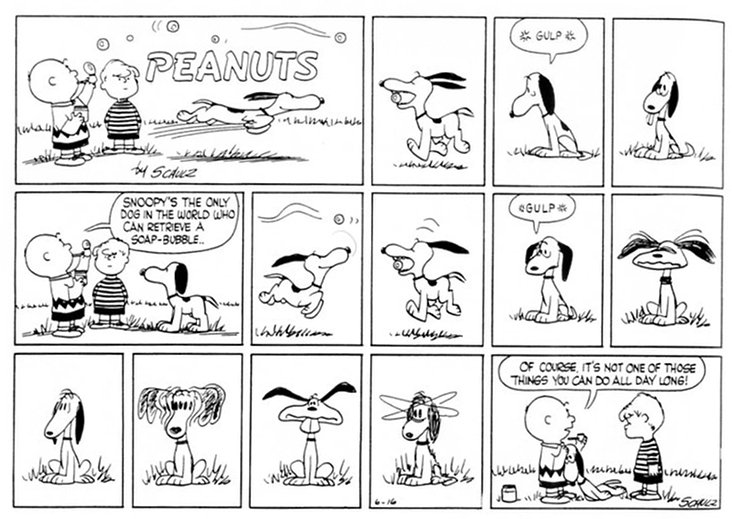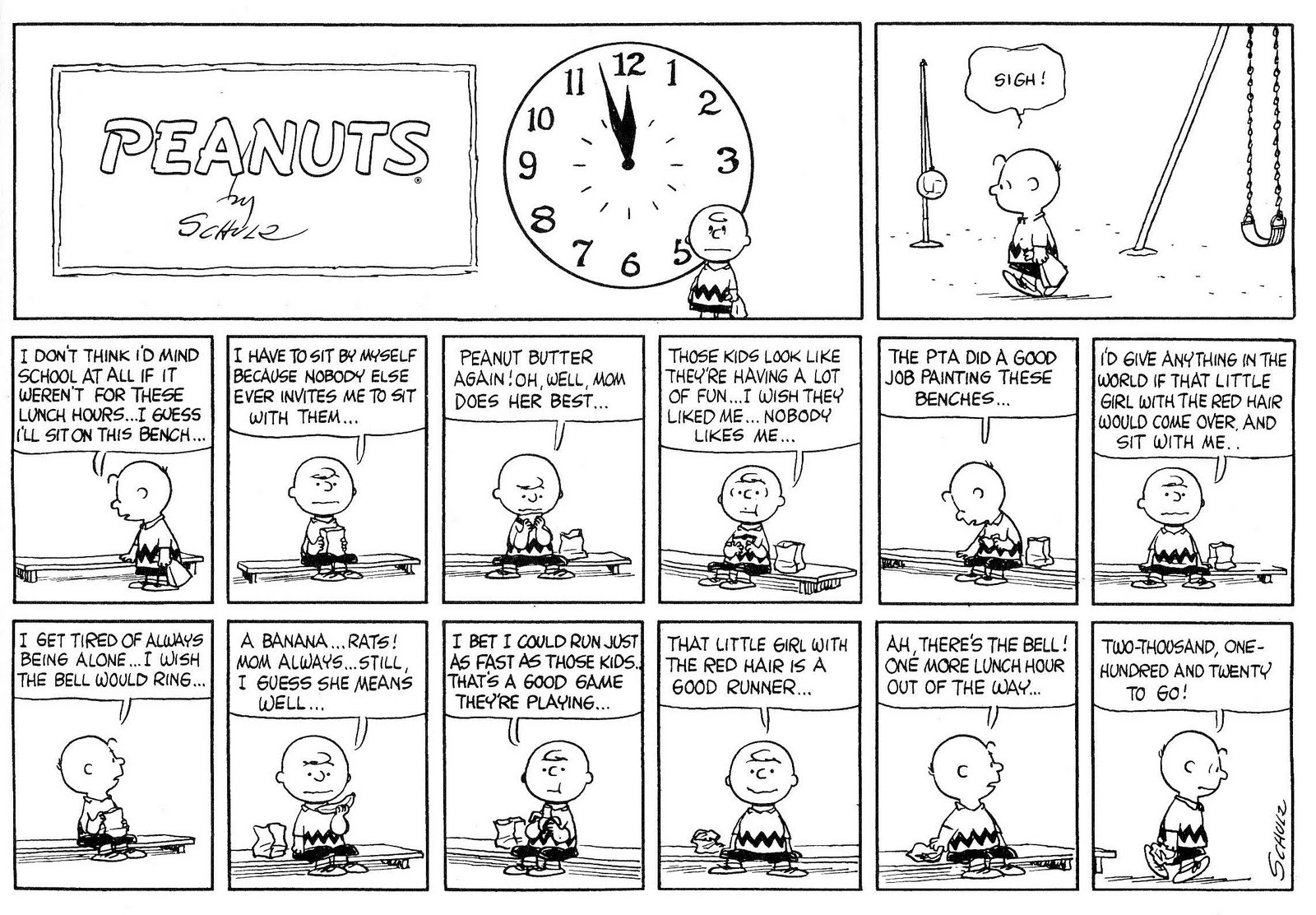There are two main paths to liking Peanuts: the Snoopy way and the Charlie Brown way.
The Snoopy way focuses on the strip’s plush centerpiece; the irrepressibly imaginative and adorably ill-proportioned polymorphous people-pleasing juggernaut. Snoopy combines Hobbes’ furry lovableness with Calvin’s mischievous bad-boy allure; he’s cuter than Hello Kitty and more whimsically unpredictable than Opus. His is a face that launched a million lunch boxes and a massive life insurance campaign—he’s the personification of Schulz’s marketing genius. If there were a cute overload of the funny pages, it would have an outsize schnozz and curse at the Red Baron. Snoopy is Peanuts for the masses.
The Charlie Brown way focuses on the strip’s doleful centerpiece; the downtrodden, self-pitying loser and the endless variations on his losing. Charlie Brown is existential tragedy in a baseball cap. The numbing, torturous repetition as he tears apart his sandwich while watching the red-haired girl from across the playground, or the agonized howl as he strikes out yet again—this isn’t a charming diversion for the kiddies. This is a bleak vision. Charlie Brown is Peanuts for those with depth.
I actually like both Snoopy and Charlie Brown, separately and together. I find Snoopy irresistible—especially in Schulz’s earlier strips when he looked more dog-like, and when Schulz’s then-fluid line-work gave the character a vivacity that outshone even James Thurber, much less Jim Davis. And Charlie Brown is not only Beckett in miniature; he’s Beckett realizing that miniature tragedies are, through their very trivialness, even more heart-wrenching than grandiose ones. There’s some dignity in waiting for God…but waiting to finally kick the football? Transcendent cuteness and transcendent despair—a strip everyone loves, and which the people who hate what everyone loves can also love.
Still, I think that the focus on Snoopy and Charlie Brown can sometimes obscure the other players. Many of these characters, of course, have more than a touch of the stars in their make-up. Schulz drew an awful cute baby in his heyday, and it doesn’t get much more heartwarmingly precious than Linus sighing as he holds his security blanket. On the other hand, Lucy’s pursuit of Schroeder, or Linus’ pursuit of the Great Pumpkin, are as painfully hopeless as any of Charlie Brown’s repetitive failures.
But Linus and Lucy and Schroeder aren’t just a little bit Snoopy and a little bit Charlie Brown. They’re characters in their own right, with their own idiosyncrasies. Schroeder with his Beethoven obsession and his miraculous musical ability; Lucy with her determined crankiness and equally determined confusion; Linus with his contradictory nervousness and spiritual insight — they seem to have stepped out of Dickens, not out of Kafka or a marketing campaign.
Maybe the best example of this is Peppermint Patty. Patty was introduced in the ‘60s as the mercilessly competent leader of the opposition baseball team; a foil for Charlie Brown’s haplessness. Over time, though, she took on added depth, becoming one of the most complicated, and most featured, characters in the strip. Some of Schulz’s most hilariously extended narratives involve Peppermint Patty’s uncanny inability to grasp the obvious—it takes years before she realizes that Snoopy is a dog and not a funny-looking, big-nosed kid, a misapprehension that leads her to take obedience training classes, much to the disgust of her sidekick Marcie.
Schulz doesn’t just use her as the butt of jokes though. Some of his most affecting strips touch gently on Peppermint Patty’s ambivalent relationship to her tomboyishness. It’s always clear that she enjoys her ability at sports…but she also at times seems to wish to be a pretty girly-girl. She grins ear to ear when relating that her father calls her “a rare gem,” or boasts about him giving her roses for her birthday. And there’s a lovely moment when she and Lucy are planning to get their ears pierced when she looks over and declares, “I have no doubts about my femininity, Lucille!” It’s a joke because it’s a kid saying that—but it’s not really a joke on Peppermint Patty. On the contrary, it seems like a quiet affirmation; she can be a tomboy and a girl. Schulz loves her as both.
It’s easy to miss, maybe, how much love there is in Peanuts, and how much life. The strip was so long-lived, and so great on so many levels, that some of its achievements get buried. Like, for example, the fact that it arguably introduced the best three or four female characters on the funny pages—not just Peppermint Patty, but Lucy, and Sally and Marcie are surely some of the greatest women, or girls, to ever come out of the brain of a guy, be he novelist or screenwriter or artist or comics creator. If you like charming, Peanuts is charming, and if you like dark, it’s dark, but it isn’t just charming, or just dark, or even just charming and dark. There are countless ways to like Peanuts, which is no doubt why it—deservedly, inevitably—tops this poll.
Noah Berlatsky is the editor of The Hooded Utilitarian.
NOTES
Peanuts, by Charles M. Schulz, received 50 votes.
The poll participants who included it in their top ten are: Derik Badman, J. T. Barbarese, Eric Berlatsky, Noah Berlatsky, Corey Blake, Alex Boney, Scott Chantler, Jeffrey Chapman, Brian Codagnone, Dave Coverly, Warren Craghead, Tom Crippen, Katherine Dacey, Alan David Doane, Paul Dwyer, Andrew Farago, Bob Fingerman, Jenny Gonzalez-Blitz, Steve Greenberg, Geoff Grogan, Paul Gulacy, Charles Hatfield, Jeet Heer, Sam Henderson, Abhay Khosla, Molly Kiely, Kinukitty, T.J. Kirsch, Terry LaBan, John MacLeod, Vom Marlowe, Robert Stanley Martin, Chris Mautner, Todd Munson, Mark Newgarden, Jim Ottaviani, Joshua Paddison, Michael Pemberton, Stephanie Piro, Andrea Queirolo, Ted Rall, Joshua Rosen, Giorgio Salati, Kevin Scalzo, Tom Stiglich, Matthew Tauber, Jason Thompson, Mark Tonra, Matthias Wivel, and Jason Yadao.
Charles M. Schulz’s Peanuts was a daily newspaper strip that began publishing on October 2, 1950. The final original daily was published on January 3, 2000. The final original Sunday strip was published February 13, 2000. In an eerie coincidence, Schulz passed away the night of February 12.
Reprints of the strips are published in newspapers to this day under the title Classic Peanuts.
There have been innumerable book collections of the strip published over the years. A complete, chronological 25-volume hardcover collection, titled The Complete Peanuts, is currently in progress, with 15 volumes published to date.
For those looking for an inexpensive, one-volume introduction to the series, the best choice is probably Peanuts Treasury. It is published by MetroBooks, and available for sale in the discounted book section of most Barnes & Nobles. A nicely printed hardcover collection, it retails for $9.98. The book reprints over 700 strips (over 100 of them Sundays) from between 1959 and 1967, the time considered by many to be the strip’s peak period. Click here to go to its product page on the Barnes & Noble website.
–Robert Stanley Martin



I know I’ve said it before, Noah. I like your writing a lot more when you’re appreciating something rather than destroying it (excepting perhaps the infamous In the Shadow of Towers review). This is really good piece.
Aw, thanks! I like doing both (destroying and appreciating), but I think most people like the destroying better, so it’s good to have some fans for the latter.
It achieved what a good appreciation should, it made me want to pull some Peanuts off the shelf and read. (Or go get some more volumes, since I’m really behind on the collected ones, I don’t think I have any of the Peppermint Patty ones.)
The mid-70s Peppermint Patty narratives are some of the funniest things I’ve ever seen, I think. They are amazing.
About TCJ’s list Schulz said something like: being # 2 is not bad. He would be pleased today.
I never did get into the Peanuts strip as a kid, but I watched all the TV specials, every year. In fact, my brother and I watched the TV specials so often that my dad developed a deep hatred of all things Peanuts. To this day, I don’t think he can see Snoopy without cringing.
That strip on the bench is one of my all-time favorites. It captures that horrible, childhood loneliness so perfectly.
Peanuts is boring because of its ubiquity but being culturally boring doesn’t stop it from being good. I like how you focused on Peppermint Patty and I will take some time to revisit those strips.
Or in other words: nice work Noah.
I always felt like Peppermint Patty and Marcie were characters from a completely different strip that Schulz happened to shove into his life’s work. They added a great deal of life to Peanuts at a time when you could see Schulz actively try to bring in new characters to see who’d stick.
I completely agree with this, and I didn’t even vote. I kind of assumed we were voting only for recent comic books, which I am only sort of up on if “recent” means “ten years ago.”
I totally disagree that Peanuts is boring. WASPy perhaps, but (other than that) not boring. The Beatles were great, but you can hear them in all white music. Peanuts– you can see it in Calvin and Hobbes, but, despite Bill Watterson’s technical facility and occasional zingers, it just seems so much more like everything else, in terms of ink brush drawing design, sitcom jokes, etc., whereas Peanuts is just weird. There’s a way in which a New Yorker cartoon has sloppy drawing and makes you think “was that supposed to be funny?,” and so does Cathy.
But neither of those things are like Peanuts. Snoopy’s doghouse doesn’t “morph” into a biplane, but a cat can slash precise shapes and words out of it with its claws, and Snoopy will thus defend his doghouse with a giant sandwich for a full week of strips. Linus doesn’t get fixated on words with potentially off-color connotations, he gets hung up on words like “fanatic” and “barrel-staves.”
It’s bizarre, it’s life-affirming, it’s Christian, it’s alientated, it’s ironically poignant without being poignantly ironic– I can’t believe how unusual Peanuts still is.
The Beatles are a great comparison. Similarly omnipresent, similarly sometimes denigrated for their omnipresence, yet still despite the omnipresence odd and wonderful. Biggest difference being the Beatles only lasted for a decade, while Schulz was around for 50 years….
“Ironically poignant without being poignantly ironic” is a brilliant description.
Great piece. I have one last thing to add. Peanuts, at its best, was just funny, laugh-out-loud funny, and that’s no small thing.
You nailed this, Noah. The other commenters made excellent points, too. If it hadn’t been funny, all its other qualities might not have mattered.
Pingback: La classifica dei 115 migliori fumetti del mondo
Pingback: October 2011 banner by Schulz | The Comics Grid: Journal of Comics Scholarship | admin
I just want to thank you for put the strip of november 19 , 1961 , because i was looking for that strip, because it’s the first mentioned of the Little Red-Haired Girl
Thank you so much
I’m sorry, but Peanuts is far from number one. Krazy Kat is and will always be number one. Comparing Peanuts to the Beatles is totally off. Comparing Peanuts to Journey is more like it.
Journey is great; not much like Peanuts, but it has its own virtues.
Pingback: Bill Watterson on Peanuts | Alas, a Blog